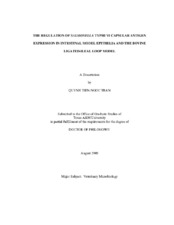| dc.description.abstract | Salmonella enterica serovar Typhi, a major public health concern in developing countries, continues to be a priority for the World Health Organization. S. Typhi possesses a viaB locus responsible for the biosynthesis of the Vi-capsular antigen, a significant virulence factor at the focus of developing improved prophylaxis for typhoid fever. Tissue culture experiments have demonstrated that S. Typhi wild-type capsule-expressing strain elicits less chemokine secretion than a viaB mutant. Calf experiments using the viaB mutant resulted in an increase inflammatory response. Osmolarity is one of the control signals that affect the biosynthesis of the Vi antigen. Under high osmolarity growth conditions of 300 mM and greater, Vi production is suppressed and S. Typhi is highly invasive. Studies reveal that the viaB mutant displays increased invasion towards intestinal epithelial cells. Our first objective was to implement direct and indirect methods to localize and detect Vi expression within intestinal epithelial cells and bovine Peyer's patch. The second objective was to compare the invasiveness between a viaB mutant, an ompR mutant, and S. Typhi grown under hyperosmolarity. We also measured the effects of these strains in eliciting inflammation in the calf model.
We report that tviB was significantly up regulated intracellularly within T84 polarized cells. In the calf experiments, tviB was expressed at levels significantly higher in calf tissue following invasion compared to inoculum grown under Vi-suppressing conditions. Together, these results support the idea that the Vi capsular antigen is expressed after invasion of intestinal epithelial cells in vivo.
We found that S. Typhi grown under high osmolarity, the viaB mutant, and the ompR mutant had increased invasion in polarized T84 cells and bovine ileal tissue. Fluid accumulation among Vi-deficient and Vi-suppressed strains was similar. The histopathology of the inflammatory lesions of the small intestine produced by the Vi-deficient and suppressed strains was quite comparable. Our data supports the notion that Vi-suppressed and Vi mutants of S. Typhi exhibit similar levels of increased invasion and inflammation, perhaps mechanistically through the inactivation of the Vi antigen. | en |


